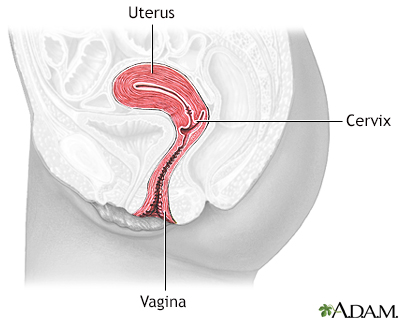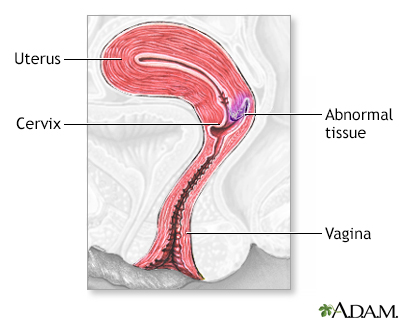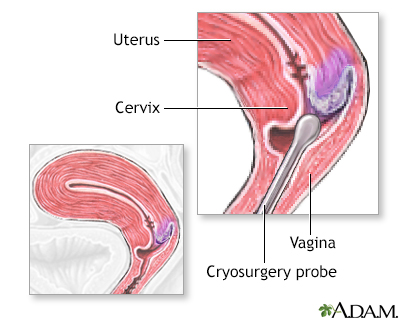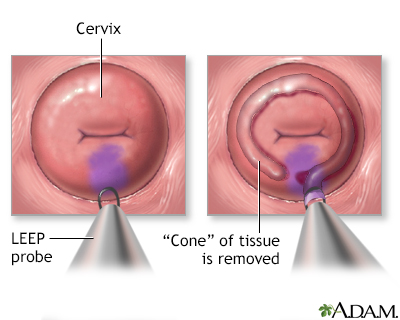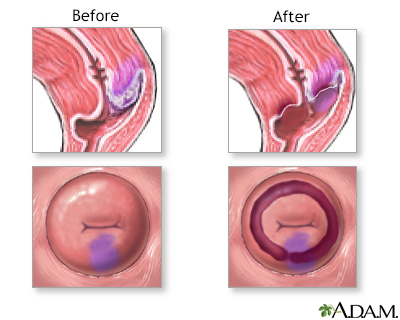Cervical dysplasia
Normal anatomy
|
|
The cervix is the tissue that leads from the uterus into the vagina.
|
Indications
|
|
Cervical cancer is one of the most common cancers in women. It is a cancer of the epithelial tissue of the cervix. Pap smear is the screening procedure used to detect cervical cancer. Limited or early cervical cancer (carcinoma in situ, or cervical intraepithelial neoplasia, or dysplasia) requires treatment with ablation therapy, usually in the form of cervical cryotherapy, or a more extensive procedure, called conization, which removes more tissue.
|
Procedure, part 1
|
|
Ablation therapy is frequently performed using a cryoprobe. A hollow metal probe, through which flows extremely cold liquid nitrogen, is inserted into the vagina and applied to the cervix and held in place for 5 to 10 minutes. This freezes, and thus destroys, the superficial tissues of the cervix which contains the dysplastic tissue.
|
Procedure, part 2
|
|
Conization is a procedure in which a "cone" of tissue is removed. This procedure is performed for more advanced cervical dysplasia, which remains limited to the cervix (cervical intraepithelial neoplasia, high grade). It allows the surgeon to remove more cervical tissue.
Conization is performed using either a knife, laser, or electrocautery. LEEP, or the loop electrosurgical excision procedure is the term used for conization electrocautery. In this procedure, an electric current is run through a loop of wire, which is used to perform the conization. It is the most common method used for conization.
|
Aftercare
|
|
If the tissue removed by conization shows residual tumor, or invasive cancer, then further treatment is necessary. This often consists of surgical removal of the uterus and cervix (hysterectomy).
|

Review Date:1/10/2022
Reviewed By:John D. Jacobson, MD, Department of Obstetrics and Gynecology, Loma Linda University School of Medicine, Loma Linda, CA. Also reviewed by David Zieve, MD, MHA, Medical Director, Brenda Conaway, Editorial Director, and the A.D.A.M. Editorial team.
The information provided herein should not be used during any medical emergency
or for the diagnosis or treatment of any medical condition. A licensed medical professional
should be consulted for diagnosis and treatment of any and all medical conditions. Call 911
for all medical emergencies. Links to other sites are provided for information only -- they
do not constitute endorsements of those other sites. © 1997-A.D.A.M., Inc. Any duplication or distribution of the information contained herein is strictly prohibited.
The Agency for Health Care Administration (Agency) and this website do not claim the information on, or referred to by, this site is error free. This site may include links to websites of other government agencies or private groups. Our Agency and this website do not control such sites and are not responsible for their content. Reference to or links to any other group, product, service, or information does not mean our Agency or this website approves of that group, product, service, or information.
Additionally, while health information provided through this website may be a valuable resource for the public, it is not designed to offer medical advice. Talk with your doctor about medical care questions you may have.

